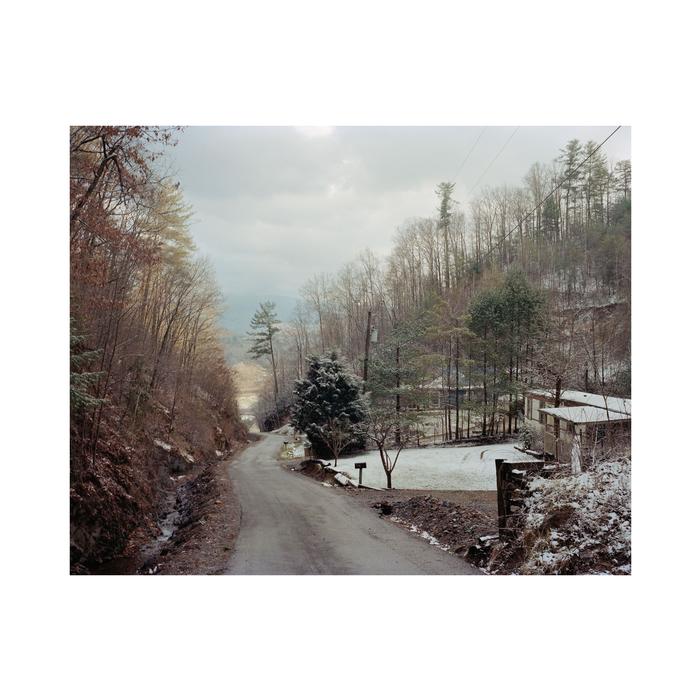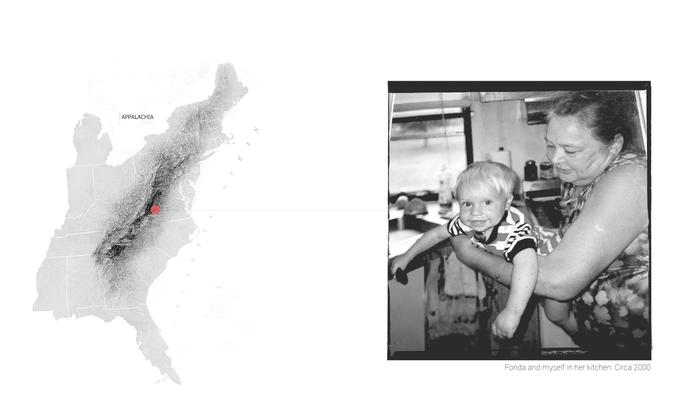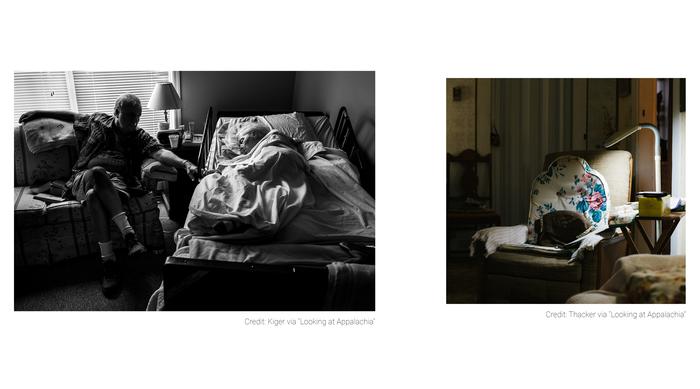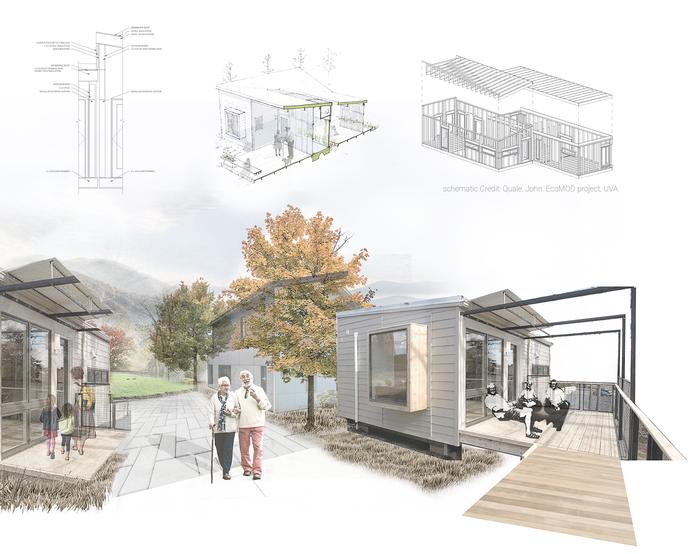Hayden Painter-EssayA Vision for Aging in Rural AppalachiaA moment is delicate
A glint of frost in crisp dawn
What will become of us in time?
There’s a place nestled deep in the foothills of Virginia's Blue Ridge Mountains that will never leave me. I always arrived well after sunset. My father would wake me as we turned into a gravel drive after hours of travelling on snaking country roads. I remember the sweet night air and the soft refrain of crickets. Moths flickered by a single porch light as we lugged our suitcases up to my grandmother’s door.
My grandmother’s name was Fonda. Her trailer sat rooted in the soil, at the base of a briar-choked railroad embankment. Out her kitchen window, past a handsome row of pines, the Shenandoah River marked the edge of her property. Over the years, I watched Fonda age right here — in rural Appalachia.
She would often reminisce over a life in the Appalachian Mountains, a region with a storied and misty history. Originally the home of the Cherokee people, settlement by primarily Scotch-Irish immigrants began in the 1730s (Kehrli). Today, the Appalachian region encompasses 423 counties in 13 states ranging from New York to Mississippi (“About the Appalachian Region”). The ridges and hollows have bred seclusion and traditionalism, and modern stigma paints the people of this place with coarse brushstrokes. Fonda paid no mind. She valued her home, her friends and her family deeply. If she had her people, all was right.
However, what happens when we age? What happens to someone in a place like this, where winding mountain roads separate friends, where a withdrawal of industry and growing urbanization has bled the region of young people, where elderly females in particular experience high rates of poverty? Will one have support and companionship in later life?
I believe Fonda’s situation is applicable to many older adults in this region. By sharing her story, I aim to posit a vision for the future of aging in rural Appalachia.
Fonda
I remember running errands with Fonda when I was young. I was relegated to the passenger seat, attempting to wrangle hot, foil-wrapped dishes as she put the hammer down. We would be out all day, winding our way from one persons’ house to another. Always an awkward kid, I would wait in the car as she delivered food. I also needed the time to center myself, collecting a few deep breaths before careening off again.
Out on the road, Fonda would explain the person’s situation in full lurid, southern gothic detail. So-and-so was going through a rough patch, someone’s son just came home from prison, or else it was simply someone she hadn’t seen in far too long. She cooked for all of them, producing a full range of comfort food from the tiny, ancient oven in her trailer.
She bought the trailer for $24,000 in 1989 (approx. $57,000 today). At 56 feet long and 14 feet wide, it was more than enough. Before this, she lived in a tall blue building right off the train track. Once a railroad outpost and general store, the house had a dirt floor, no heat, water or sewer. When my father was born, this made three generations living under one roof. At many times, it was uncomfortable, cramped, and cold, but it was never lonely. In those days, one would insure themself against the challenges of aging by investing in one’s family, and companionship was the currency of this system.
Fonda valued company and she invested in relationships. And for much of her life, her trailer home was lively with the comings and goings of neighbors, friends, and relatives. Late summer days would see her picking tomatoes from her garden with children; smokey card games with the screen doors open; people stopping by to drop off a gift or pick up a tray of her famous rolls.
But eventually, age started to affect Fonda’s mobility. She could no longer drive at night, making bingo, potlucks, basketball games, and our errands impossible. While this is natural and expected, her rural location compounded the difficulty of aging. As her participation in social circles decreased, it seemed the tapestry of her support system began to unravel. Eventually, some people stopped coming by. They moved on. To many, it seemed that she was no longer visible.
As a result, despondency pressed in upon her, at times all but crushing her spirit. My father called her daily and started visiting for months at a time. His presence inspired dramatic improvement, but soon after he would leave, she would spiral again. Fonda got her light from helping others, and reciprocally, she needed companionship to feel her best.
Loneliness
In America, among older adults, loneliness has been identified as the most significant factor in predicting a lower quality of life. Loneliness has been linked to multiple chronic conditions including hypertension, coronary artery disease, metabolic syndrome, diabetes, and lung disease (Theeke). After Fonda began experiencing isolation, she developed cardiac complications. Eventually her condition necessitated entry into a cycle of nursing homes and hospitals that would define her final years.
Fonda passed away in a hospital in February 2019. In the weeks before she passed, she pulled me close and whispered that she would rather be anywhere else. As beautiful as her home had been, its rurality turned the natural process of aging into isolation. This loneliness contributed to a decline in health, and her only option became the healthcare system.
My Grandmother was a wellspring of knowledge and kindness. Aging never detracted from all she had to offer. However, rural Appalachians are confined to three options in later life: aging in place, aging in nursing homes, and extended stays in hospitals.
This is a design problem. When considering aging, can we conceive a fourth option — one that guarantees companionship and purpose? A structure of living that is proactive rather than reactionary? Imagine a place where people age with optimism, reducing premature entry into eldercare. Just after Fonda passed, such a place was opening its many doors 60 miles away.
Cohousing
Emerson Commons is a multigenerational cohousing development in the mountain town of Crozet, Virginia. Described by residents as an “intentional neighborhood”, 49 people live in 26 homes clustered on 3.5 wooded acres (“About our Community”). Welcoming front porches face a common green, community gardens, a pool, a playground and a firepit. A historic farmhouse overlooks this communal yard and serves as a gathering place for meals, events, and game nights.
The community follows the Danish model of cohousing, where private, high-density homes are supplemented by beautiful common spaces and shared facilities. Modern cohousing started in Denmark in the 1960s, but in many ways, this model is a return to past living structures of Appalachia. When Fonda lived in the blue house, seniors and children took on roles of altruism depending on their ability. The elders raised my father and his brother, equipping them with skills and knowledge amassed over lifetimes in the mountains. In turn, when elders became frail, my father provided care and companionship. Author Loyal Jones lists “self-reliance… [and] familism” as two guiding principles for Appalachians in his 1994 book Appalachian Values. Those who moved to Emerson certainly exhibit these values through intentional investment in their community. What emerges from shared meals, facilities, activities, chores, and recreational spaces is a self-reliant community that is often described as a large family.
Over a typical fall day in Emerson, children may race around the common green unfettered, lightly supervised by a few adults. An older man sits on his front porch with a young boy, grease on their hands as they repair the axle of his go-kart. The sugar maples and persimmons glow crimson as a couple strolls along the edge of the development, tracing a familiar path through miles of accessible trails. Parents set kids loose on building a fire. The blaze crackles long into the night, setting the backdrop for an evening of traditional Appalachian string music played by two community members. At one point, an elderly woman may bring brownies down to the fireside, aided by a teenager. Here, everyone has a place, and loneliness melts away.
Emerson sets a precedent for age-friendly living in rural Appalachia. It balances privacy with built-in social integration. The community is also light on the land. In a standard Crozet suburb, 26 homes occupy approximately three times as much land as Emerson. It is also Virginia’s first all-solar community and houses exceed code requirements to prioritize resident health and comfort. However, the price of a home here is a significant barrier for low-income Appalachians. Fonda would have been unable to afford Emerson, but by rethinking ownership structures and construction methods, an affordable option becomes attainable.
Affordable Community Structure
The first step in developing an accessible, age-friendly community is forming a Community Land Trust (CLT). A board of stakeholders purchases land and works with design firms to bring the site to life. Once homes are constructed, residents enter into a long-term lease with the Trust. Since residents do not own land, house prices remain affordable. Simultaneously, deed restrictions can be implemented, capping the appreciation of a home and ensuring affordability for future owners.
Imagine a cohousing community where house prices remain low, allowing for a diverse array of residents. Several homes could be deed restricted, specifically geared towards older, low-income tenants. For these elders, community and secure housing may take priority over wealth-generation and profit. A resident who wishes to age in place may be willing to forego significant resale value in favor of an accessible price point.
The CLT is only part of this equation, however. The second step in developing an accessible age-friendly community requires careful home design. A home must be familiar, dignified, and responsible in order to be successful in this context. In considering the vernacular architecture of rural Appalachia, the prefabricated home appears frequently. Many aging residents are familiar with modular living structures and modest footprints. In fact, one county over, in West Virginia, we see the fourth highest percentage of mobile homes — or “trailers” — in the nation (Boettner).
Healthy Homes
Trailers are affordable but do not qualify for federally backed mortgages and are subject to restrictive zoning. In addition, many mobile homes pose dangers to the health of seniors. In Fonda’s case, her trailer received minimal daylighting, experienced wild temperature swings, and had horrible indoor air quality. My father discovered and removed a massive black mold infestation in her closet. Fonda once fell straight through the flimsy floor, the roof leaked, and the walls were barely insulated. Substandard construction and cheap materials are commonplace, but prefabrication can provide responsible and dignified solutions.
The University of Virginia’s School of Architecture demonstrated the potential of modular prefab design in 2004. The project, called ecoMOD, started in 2004 under Professor John Quale. The goal was to design, build, and evaluate high-performance, affordable homes for low-income Appalachian residents. Quale's method hinges on buying bulk material, reducing change orders, and building with minimal delay and waste. Parts are trucked to the site, boomed into place and assembled quickly, reducing the cost of the construction, and thus, the overall cost of the home.
In 2009, ecoMOD built a 990 square-foot, two-bedroom home in Charlottesville for $150,000 — about 60% the cost of Emerson’s “affordable” units. The ecoMOD design is near-zero energy, features super-insulated wall assemblies, a solar array, and a geothermal heat pump. Other projects have utilized green roofs, solar water heaters, and potable rainwater collection systems (“EcoMOD3”). These features support Appalachian values of independence, self-reliance, and connection with nature while reducing energy consumption.
In addition, ecoMOD partnered with UVA’s Institute on Aging, Jefferson Area Board on Aging, and UVA’s Medical Automated Research Center to tailor designs to seniors. Another one-bedroom project in Charlottesville features full ADA compliance, zero VOCs, and noninvasive medical monitoring equipment. An access ramp of reclaimed & resawn timber slats leads into the warmly furnished home. Controls and appliances are situated to accommodate a wheelchair-bound occupant, and high-efficiency ventilation systems ensure premium indoor air quality. The modular design readily accepts a second bedroom addition in the event that housing a caregiver becomes necessary. The cost of this unit was $50,000, comparable to what Fonda paid for her trailer in 1989. However, this home is considered permenant and qualifies for loans and financing.
EcoMOD unit plans have been published with the hope that mobile home manufacturers take notice. These archetypes are healthy and effective. The inhabitants of ecoMOD’s first home are using 50% less energy than a comparable house, saving low-income residents money while reducing their environmental impact (EcoMOD).
Vision
If these responsible designs were implemented in Community Land Trust-owned cohousing developments, older adults in rural Appalachia would benefit. These developments should be located in small towns bordering larger cities. Much like Emerson, residents could enjoy pedestrian access to town centers while still feeling "tucked away". Natural features like creeks, forests, and lakes would support physical and mental health. These communities thrive when they are multigenerational, and proximity to larger cities would accommodate a variety of residents; families, younger couples, and previously rural seniors. Landscapes should feature a communal gathering place, gardens, workshops, playgrounds, walking trails, and recreational opportunities for all ages and abilities. In these intentional neighborhoods, everyone has a place.
Of course, this lifestyle relies on compromise. Residents must relinquish some privacy and ownership to enjoy the benefits of social integration. This structure is not for everybody, but it can melt away the isolation that creeps through Appalachia’s aging populations. If such a community existed during Fonda’s lifetime, she would have wholeheartedly participated in its formation. Her generosity of spirit, rye sense of humor, and heartwarming soul food would have brought light to any intentional neighborhood. And in turn, she would have received the companionship she needed to shine her brightest.
Within the misty hollows and forested ridges of Appalachia, people will continue to live and age. As human beings, we will always require warmth. Like moths to the glow of a porch light, we’re drawn to the company of others. We need confirmation that we matter to someone; that we’re still visible. In the foothills of the Blue Ridge Mountains, a woman who mattered to me lived, aged, and passed. Across the country, many people are undergoing a kindred experience, and they all deserve the option of community.
References
“About our Community.” Emerson Commons, Emerson Commons Cohousing
“About the Appalachian Region” Appalachian Regional Commission
Boettner, Ted. “Home Ownership in West Virginia: Quality vs Quantity.” 31 January 2013. West Virginia Center on Budget and Policy.
“EcoMOD Project.” World Habitat Awards/Winners, 2 May 2018
Ford, Jane. “EcoMOD3 Expands Modular, Sustainable, Affordable Housing Research.” 20 August 2007. University of Virginia
Greenstein, Rosalind et al. “Community Land Trusts.” April 2005. Lincoln Institute of Land Policy
Jones, Loyal, and Warren E. Brunner. Appalachian Values. Jesse Stuart Foundation, 1994.
Kehrli, Susan Downs. “Poverty or Promise? The Paradox of Appalachian Life and Values.” Thesis, California State University, Dominguez Hills ProQuest Dissertations Publishing, 2005
Quale, John. “EcoMOD: Sustainable, Prefabricated and Affordable Housing Prototypes.” 95th ACSA Annual Meeting Proceedings, Fresh Air
Theeke, Laurie A et al. “The Experience of Older Women Living with Loneliness and Chronic Conditions in Appalachia.” Rural mental health vol. 39, 61-72. 1 April 2015. doi:10.1037/rmh0000029 Additional Help and InformationAre you in need of assistance? Please email info@berkeleyprize.org. |




